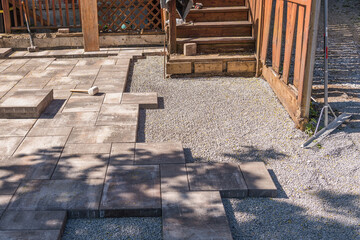If you’re seeing cracks that don’t connect and a recessed area where water collects, repair is a must. Water damage over time erodes pavement and can lead to foundation problems.

If your concrete or asphalt driveway is in poor condition and showing signs of significant wear and tear, consider replacing it. Driveway Replacement Colorado Springs will provide a beautiful new surface that’s easy to drive on and adds value to your home.
Large cracks, discoloration, and concrete spalling can be covered with resurfacing or a concrete overlay. This allows you to add stamping or engraving for a custom look at a lower cost than replacement.
Your driveway does a lot of work, so it’s no surprise it eventually wears out. Cracks, stains, mold, heaving, drainage problems and age can all contribute to your driveway’s poor condition. Repairing your driveway can help restore its function and appearance, but you have to decide whether to patch, resurface or replace it entirely. Your choice depends on the type of material your driveway is made of: asphalt, concrete or gravel.
Concrete driveways that are cracked or pitted can be repaired with a concrete resurfacer and a fresh coat of sealer. This is a quick way to fix a tired-looking driveway and is less expensive than replacing it. For best results, thoroughly clean the area of the driveway where you plan to make repairs. If the surface is dirty, it will prevent the new material from adhering. Use a pressure washer to remove dirt, mud and debris from the driveway surface. You can also purchase a concrete cleaner, such as ACT Microbial Concrete Cleaner (available at Home Depot), that contains strong degreasing agents or agents that remove mold and mildew. This product is mixed with water in the pressure washer and applied to the affected areas of the driveway.
If you have a concrete driveway with small cracks that are less than half an inch wide, they can be fixed by using a liquid crack filler such as Quikrete Advanced Polymer Concrete Crack Sealant (available at The Home Depot) that is dispensed from a caulking gun. This prevents water from penetrating the cracks and freezing, which can cause further damage to your driveway. Preventive measures include removing trees with roots near your driveway and having the roots professionally removed, sealing your concrete annually and resurfacing with a quality resurfacer every two to three years.
For more extensive cracking and discoloration of concrete, resurfacing with a concrete overlay may be an option. This product, which is a cement-based product applied directly over the existing concrete, allows you to add decorative finishing touches and gives your driveway a new look without the expense of replacing it.
Resurfacing
If your driveway has small cracks or a lot of pitting, you can often improve its look by resurfacing it with an asphalt or concrete resurfacer. However, it’s important to remember that resurfacers are essentially cosmetic finishes that will only mask the damage for a short period of time. If your driveway is in serious need of repair, it’s better to replace it rather than resurface it.
To prepare for resurfacing, first clean the driveway to remove any dirt or other debris that might be trapped underneath the surface. Next, tape off the expansion joints and any other areas where the resurfacer will be applied. This will prevent the resurfacer from bleeding through the concrete and damaging it underneath. It’s also a good idea to apply a primer before you use the resurfacer.
Concrete resurfacers are available in a wide variety of finishes, so you can choose a color and texture that best matches the existing surface. You can even get textured or slip-resistant resurfacing products that will add an extra level of safety to your driveway. When applying the resurfacer, be sure to work in sections and spread it evenly across the driveway. If you’re using a textured product, brush it afterward to ensure that the finish is distributed evenly.
Lastly, you should allow the resurfacer to set for the recommended amount of time before walking on it. Once it’s fully dry, you can then apply a sealer to help protect the new surface.
For some, resurfacing is the perfect middle ground between patching and replacing your entire driveway. This is especially true if the cracks in your driveway are less than a quarter-inch wide and don’t affect the structural integrity of the concrete. However, for driveways that have significant cracking or other damage, it may be more cost-effective to simply replace them with a new slab. For instance, major damage could indicate that the concrete was poured improperly or didn’t set properly, so it would need to be replaced in order to prevent further damage from water seepage and freezing temperatures.
Replacement
The first step is deciding what material you would like for your new driveway. The two most popular choices are concrete and asphalt. Concrete is generally more expensive but has a longer lifespan than asphalt. It is also more durable and resistant to weather conditions.
If you have an existing concrete or asphalt driveway that has small cracks and fissures in it you might want to repair those areas instead of completely replacing your entire driveway. However, if the concrete is starting to crack in alligator or spiderweb patterns or large chunks are missing it is definitely time for a replacement.
Another important factor to consider is the age of your current driveway. If it’s over 20 years old you should seriously consider replacing it. This is especially true if you are starting to see a lot of cracks in the concrete.
A new driveway can be made of several different materials, including asphalt, concrete, brick or recycled rubber. If you’re unsure what to choose, a professional can help you decide which will best suit your needs and property.
Regardless of what kind of material you choose, it’s important to shop around and get quotes from a few contractors before making any decisions. This can save you a lot of money in the long run. You should also make sure that the contractor you choose uses high-quality materials. This will ensure that your new driveway lasts as long as possible.
Once you’ve replaced your old driveway you can choose to decorate it further with staining or stamping, which will increase its curb appeal and give it a unique look that can’t be achieved with just paint. Creating a new driveway can be an investment, but it’s one that will pay off in the long run with peace of mind and improved curb appeal.
Curb Appeal
It’s no secret that curb appeal matters when it comes to selling a home. In fact, it can make the difference between your house staying on the market for months or finding a new owner almost immediately. A few minor upgrades can give your property the “wow” factor that’s so crucial in real estate and attract the attention of prospective buyers from a distance.
Whether you’re thinking about selling your property or simply want to make it more attractive, these easy, budget-friendly fixes will add to your curb appeal:
Repair any cracks and stains in your driveway (and kill any weeds that are sprouting). Clean out and stain your concrete paths, paving stones, or bricks to create a distinct division between the paved and unpaved areas of your property. Adding a fresh coat of paint to your front door and any exterior trim pieces can instantly improve your home’s look, as well as make it easier for your neighbors to identify your residence from the street.
Landscape your property with low maintenance shrubs, flowers, and grasses that coordinate with your home’s color scheme. Remove any overgrown shrubs or trees, and trim the ones that are thriving to keep them in good shape. Make sure the mulch is fresh, and that all your plants are free of pests and debris to create a healthy, welcoming look.
Don’t forget to include a fresh-looking mailbox that matches the rest of your property’s design. Add a row of low-voltage lighting along your walkways or near any important landscaping features to help illuminate your property at night.
Business Curb Appeal
Just as with homes, curb appeal plays an important role in attracting customers for businesses. A neat, clean, and organized exterior shows potential clients that you care about their experience at your business and will likely result in increased customer traffic. Adding a row of low-voltage lights to your sidewalks and pathways, removing any weeds or overgrown vegetation, painting your entryway doors a vibrant color, and adding a new or upgraded mailbox are just a few ways you can enhance your company’s curb appeal.






